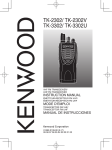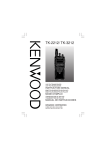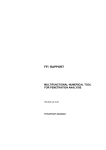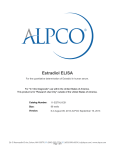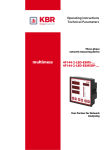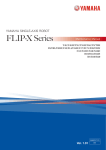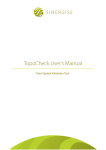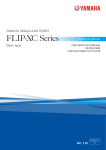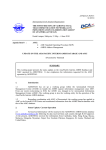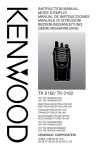Download TK-2000 TK-3000
Transcript
INSTRUCTION MANUAL THANK YOU We are grateful you have chosen Kenwood for your land mobile radio applications. NOTICES TO THE USER ◆ Government law prohibits the operation of unlicensed radio transmitters within the territories under government control. ◆ Illegal operation is punishable by fine and/or imprisonment. ◆ Refer service to qualified technicians only. Safety: It is important that the operator is aware of, and understands, hazards common to the operation of any transceiver. PRECAUTIONS • • • • • Do not charge the transceiver and battery pack when they are wet. Ensure that there are no metallic items located between the transceiver and the battery pack. Do not use options not specified by Kenwood. If the die-cast chassis or other transceiver part is damaged, do not touch the damaged parts. If a headset or headphone is connected to the transceiver, reduce the transceiver volume. Pay attention to the volume level when turning the squelch off. Do not place the microphone cable around your neck while near machinery that may catch the cable. Do not place the transceiver on unstable surfaces. Ensure that the end of the antenna does not touch your eyes. When the transceiver is used for transmission for many hours, the radiator and chassis will become hot. Do not touch these locations when replacing the battery pack. Do not immerse the transceiver in water. Always switch the transceiver power off before installing optional accessories. For safety reasons, we recommend that the AC adapter (for the battery charger) should be connected to an easily accessible AC socket. • • • • • • • VHF FM TRANSCEIVER TK-2000 UHF FM TRANSCEIVER TK-3000 NOTIFICATION This equipment complies with the essential requirements of Directive 1999/5/EC. The use of the warning symbol means the equipment is subject to restrictions of use in certain countries. This equipment requires a licence and is intended for use in the countries as below. AT IE SE LT BE IT CH MT DK LI GB PL FI LU CY SK FR NL CZ SI DE NO EE BG GR PT HU RO IS ES LV ISO3166 Turn the transceiver power off in the following locations: • In explosive atmospheres (inflammable gas, dust particles, metallic powders, grain powders, etc.). • While taking on fuel or while parked at gasoline service stations. • Near explosives or blasting sites. • In aircrafts. (Any use of the transceiver must follow the instructions and regulations provided by the airline crew.) • Where restrictions or warnings are posted regarding the use of radio devices, including but not limited to medical facilities. • Near persons using pacemakers. • • • • • © B62-2418-00 (E, T) 09 08 07 06 05 04 03 02 01 00 Information concerning the battery pack: The battery pack includes flammable objects such as organic solvent. Mishandling may cause the battery to rupture producing flames or extreme heat, deteriorate, or cause other forms of damage to the battery. Please observe the following prohibitive matters. • • • • • • • • • • • Do not disassemble or reconstruct battery! The battery pack has a safety function and protection circuit to avoid danger. If they suffer serious damage, the battery may generate heat or smoke, rupture, or burst into flame. Do not short-circuit the battery! Do not join the + and – terminals using any form of metal (such as a paper clip or wire). Do not carry or store the battery pack in containers holding metal objects (such as wires, chain-necklace or hairpins). If the battery pack is short-circuited, excessive current will flow and the battery may generate heat or smoke, rupture, or burst into flame. It will also cause metal objects to heat up. Do not incinerate or apply heat to the battery! If the insulator is melted, the gas release vent or safety function is damaged, or the electrolyte is ignited, the battery may generate heat or smoke, rupture, or burst into flame. Do not leave the battery near fire, stoves, or other heat generators (areas reaching over 80°C)! If the polymer separator is melted due to high temperature, an internal short-circuit may occur in the individual cells and the battery may generate heat or smoke, rupture, or burst into flame. Do not immerse the battery in water or get it wet by other means! If the battery’s protection circuit is damaged, the battery may charge at extreme current (or voltage) and an abnormal chemical reaction may occur. The battery may generate heat or smoke, rupture, or burst into flame. Do not charge the battery near fire or under direct sunlight! If the battery’s protection circuit is damaged, the battery may charge at extreme current (or voltage) and an abnormal chemical reaction may occur. The battery may generate heat or smoke, rupture, or burst into flame. Use only the specified charger and observe charging requirements! If the battery is charged in unspecified conditions (under high temperature over the regulated value, excessive high voltage or current over regulated value, or with a remodeled charger), it may overcharge or an abnormal chemical reaction may occur. The battery may generate heat or smoke, rupture, or burst into flame. Do not pierce the battery with any object, strike it with an instrument, or step on it! This may break or deform the battery, causing a short-circuit. The battery may generate heat or smoke, rupture, or burst into flame. Do not jar or throw the battery! An impact may cause the battery to leak, generate heat or smoke, rupture, and/or burst into flame. If the battery’s protection circuit is damaged, the battery may charge at an abnormal current (or voltage), and an abnormal chemical reaction may occur. The battery may generate heat or smoke, rupture, or burst into flame. Do not use the battery pack if it is damaged in any way! The battery may generate heat or smoke, rupture, or burst into flame. Do not solder directly onto the battery! If the insulator is melted or the gas release vent or safety function is damaged, the battery may generate heat or smoke, rupture, or burst into flame. • • • • • • • • • • • Do not disassemble or modify the transceiver for any reason. Do not place the transceiver on or near airbag equipment while the vehicle is running. When the airbag inflates, the transceiver may be ejected and strike the driver or passengers. Do not transmit while touching the antenna terminal or if any metallic parts are exposed from the antenna covering. Transmitting at such a time may result in a high-frequency burn. If an abnormal odor or smoke is detected coming from the transceiver, switch the transceiver power off immediately, remove the battery pack from the transceiver, and contact your Kenwood dealer. Use of the transceiver while you are driving may be against traffic laws. Please check and observe the vehicle regulations in your area. Do not expose the transceiver to extremely hot or cold conditions. Do not carry the battery pack with metal objects, as they may short the battery terminals. Danger of explosion if the battery is incorrectly replaced; replace only with the same type. When operating the transceiver in areas where the air is dry, it is easy to build up an electric charge (static electricity). When using a earphone accessory in such conditions, it is possible for the transceiver to send an electric shock through the earphone and to your ear. We recommend you use only a speaker/microphone in these conditions, to avoid electric shocks. Do not reverse the battery polarity (and terminals)! When charging a reversed battery, an abnormal chemical reaction may occur. In some cases, an unexpected large amount of current may flow upon discharging. The battery may generate heat or smoke, rupture, or burst into flame. Do not reverse-charge or reverse-connect the battery! The battery pack has positive and negative poles. If the battery pack does not smoothly connect with a charger or operating equipment, do not force it; check the polarity of the battery. If the battery pack is reverse-connected to the charger, it will be reverse-charged and an abnormal chemical reaction may occur. The battery may generate heat or smoke, rupture, or burst into flame. Do not touch a ruptured and leaking battery! If the electrolyte liquid from the battery gets into your eyes, wash your eyes with fresh water as soon as possible, without rubbing your eyes. Go to the hospital immediately. If left untreated, it may cause eye-problems. Do not charge the battery for longer than the specified time! If the battery pack has not finished charging even after the regulated time has passed, stop it. The battery may generate heat or smoke, rupture, or burst into flame. Do not place the battery pack into a microwave or high pressure container! The battery may generate heat or smoke, rupture, or burst into flame. Keep ruptured and leaking battery packs away from fire! If the battery pack is leaking (or the battery emits a bad odor), immediately remove it from flammable areas. Electrolyte leaking from battery can easily catch on fire and may cause the battery to generate smoke or burst into flame. Do not use an abnormal battery! If the battery pack emits a bad odor, appears to have different coloring, is deformed, or seems abnormal for any other reason, remove it from the charger or operating equipment and do not use it. The battery may generate heat or smoke, rupture, or burst into flame. Information on Disposal of Old Electrical and Electronic Equipment and Batteries (applicable for EU countries that have adopted separate waste collection systems) Products and batteries with the symbol (crossed-out wheeled bin) cannot be disposed as household waste. Old electrical and electronic equipment and batteries should be recycled at a facility capable of handling these items and their waste byproducts. Contact your local authority for details in locating a recycle facility nearest to you. Proper recycling and waste disposal will help conserve resources whilst preventing detrimental effects on our health and the environment. Notice: The sign "Pb" below the symbol for batteries indicates that this battery contains lead. Firmware Copyrights The title to and ownership of copyrights for firmware embedded in Kenwood product memories are reserved for JVC KENWOOD Corporation. 3 UNPACKING AND CHECKING EQUIPMENT Carefully unpack the transceiver. If any of the items listed below are missing or damaged, file a claim with the carrier immediately. Slide a battery pack or a transceiver equipped with a battery pack into the charging slot of the charger. • SUPPLIED ACCESSORIES • • • • • • • Antenna .................................................................................. 1 Battery charger/ AC adapter (KSC-35S) ................................ 1 Li-ion Battery pack (KNB-63L) ................................................ 1 Speaker/ microphone jack cover ............................................ 1 Belt clip (KBH-18) ................................................................... 1 Screw (M3 x 6 mm) ..................................................................... 1 Instruction manual .................................................................. 1 Charging slot • • ◆ Do not short the battery terminals or dispose of the battery by fire. ◆ Never attempt to remove the casing from the battery pack. 1 To install the battery pack, align the base of the battery pack with the transceiver, then press the battery pack into place until the lock lever is secure. 2 Indicator Color Lights green Receiving a call Blinks red Battery power is low while transmitting It takes approximately 3 hours to charge the battery pack. When the charger will not be used for a long time, unplug the AC adapter from the AC outlet. Blinks green Scanning 4 Alternates red and VOX gain level adjustment mode green SQUELCH LEVEL SETTING To adjust the Squelch Level, perform the following steps: 1 Turn the transceiver power OFF. 2 Rotate the Channel selector to select the “S” position. 3 Press and hold the Side key while turning the transceiver power ON. 4 Continue to hold the Side key until a beep sounds. • 5 6 • • 7 ORIENTATION VOICE OPERATED TRANSMISSION (VOX) Battery Pack Screw the antenna into the connector on the top of the transceiver by holding the antenna at its base and turning it clockwise until secure. Microphone Remove the battery pack, as described above. To install the belt clip, align the guides of the belt clip with the grooves on the rear of the battery pack, then slide the belt clip into place until the lock lever is secure. 2 Belt clip Lock lever 3 To remove the belt clip, push the lock lever towards the transceiver while sliding the belt clip up. INSTALLING THE COVER OVER THE SPEAKER/ MICROPHONE JACKS If you are not using a speaker/ microphone, install the cover over the speaker/ microphone jacks using the supplied M3 x 6 mm screw. Note: To keep the transceiver water resistant, you must cover the speaker/ microphone jacks with the supplied cover. Speaker/ microphone jack cover • 3 Channel selector Rotate to change the operating channel. 4 • 5 6 If your dealer has set the [S-Selector] function, rotate the Channel selector and select the “S” position to begin scanning. LED indicator Refer to the LED Indicator Status table. Power switch/ Volume control Turn clockwise to switch the transceiver ON. To switch the transceiver OFF, turn counterclockwise until a click sounds. Rotate to adjust the volume level. PTT (Push to Talk) switch Press and hold, then speak into the microphone to transmit. Side key Press to activate its programmable function. Speaker/ microphone jacks Insert the speaker/ microphone or headset plug into this jack. INSTALLING THE BELT CLIP 1 VOX operation allows you to transmit hands-free. This feature can be activated or deactivated by your dealer. To activate VOX and set the VOX Gain level, perform the following steps: 1 Connect the headset to the transceiver . 2 Note: The antenna is neither a handle, a key ring retainer, nor a speaker/ microphone attachment point. Using the antenna in these ways may damage the antenna and degrade your transceiver’s performance. A beep will sound. Turn the transceiver power OFF and then ON again to activate the new settings. Speaker INSTALLING THE ANTENNA The Squelch level can be adjusted from levels 1 to 9. The higher the level, the stronger the signals must be to receive. An error will occur when selecting the “10” ~ “S” positions. Press and hold the Side key for 2 seconds to save the setting. • 8 The LED indicator alternates between red and green. Release the Side key. Rotate the Channel selector clockwise to increase the Squelch level and counterclockwise to decrease the Squelch level. Antenna Antenna Meaning When charging is completed, the indicator lights green. Remove the battery pack or the transceiver from the charging slot of the charger. To remove the battery pack, push the lock lever up, then pull the battery pack away from the transceiver. Lock lever LED Indicator Status Transmitting Note: ◆ When an abnormality occurs during charging, the indicator performs as follows: Blinks red: The battery pack is either defective or the battery pack contacts are not properly mated with those of the charger. Alternates flashing green and orange: The battery pack has not satisfied the charging start temperature. Remove the battery pack from the charger and wait until it reaches a normal temperature before charging it again. ◆ The ambient temperature should be between 5°C and 40°C while charging is in progress. Charging outside this range may not fully charge the battery. ◆ The battery pack life is over when its operating time decreases even though it is fully and correctly charged. Replace the battery pack. ◆ While operating the transceiver using a Li-ion battery pack in areas with an ambient temperature of –10°C and lower, operating time may be shortened. ◆ Attention should be drawn to the environmental aspects of battery pack disposal. INSTALLING/ REMOVING THE BATTERY PACK Release the PTT switch to receive. Note: When the battery pack voltage becomes too low, transmission will stop and an alert tone will sound. Lights red Indicator PREPARATION Lock lever • Make sure the metal contacts of the battery pack mate securely with the charger terminals. The indicator lights red and charging begins. 5 PROGRAMMABLE AUXILIARY FUNCTIONS Your dealer can program the Side key each with one of the following functions. ■ None No function has been programmed. ■ Autodial DTMF Autodial allows you to make a private call to another party. ■ Monitor Momentarily press this key to deactivate QT or DQT signaling. Press the key again to return to normal operation. ■ Monitor Momentary Press and hold this key to deactivate QT or DQT signaling. Release the key to return to normal operation. ■ Scan Press this key to start scanning the transceiver channels. ■ Squelch Off Momentarily press this key to hear background noise. Press the key again to return to normal operation. ■ Squelch Off Momentary Press and hold this key to hear background noise. Release the key to return to normal operation. Rotate the Channel selector to select any position other than “S”. With the transceiver power OFF, press and hold the Side key while turning the transceiver power ON. Continue to hold the Side key until a beep sounds. • • The VOX Gain can be adjusted from levels 1 to 10 and OFF (select the “11” ~ “S” position). While speaking into the transceiver, the LED will light orange when you reach a VOX gain level that recognizes your voice. Press and hold the Side key for 2 seconds to save the setting. • 8 The LED indicator alternates between red and green. Release the Side key. Rotate the Channel selector clockwise to increase the VOX gain level and counterclockwise to decrease the VOX gain level. • 7 The VOX function does not activate when a headset is not connected to the accessory terminal of the transceiver. A beep will sound. Turn the transceiver power OFF and then ON again to activate VOX. Note: If a headset is connected to the transceiver while the VOX function is switched ON and the VOX Gain level is configured to a higher, more sensitive level, louder received signals may cause the transceiver to start transmission. BACKGROUND OPERATIONS TIME-OUT TIMER (TOT) The Time-out Timer prevents callers from using a channel for an extended duration. If you continuously transmit for the duration programmed by your dealer (default is 1 minute), transmission will stop and an alert tone will sound. To stop the tone, release the PTT switch. BATTERY SAVER When activated by your dealer, the Battery Saver function decreases the amount of power used after no signal is present and no operations are being performed for 5 seconds. When a signal is received or an operation is performed, Battery Saver turns off. Note: While the Battery Saver is operating, the LED may flash green when receiving a QT/DQT signal which does not match the QT/DQT tone/code set up in your transceiver. LOW BATTERY WARNING While operating the transceiver, the Low Battery Warning sounds an alert tone every 30 seconds and the LED indicator blinks red when the battery needs recharged or replaced. BUSY CHANNEL LOCKOUT (BCL) BASIC OPERATIONS CHARGING THE BATTERY PACK The battery pack is not charged at the factory; charge it before use. ATTENTION: Always switch OFF a transceiver equipped with a battery pack before inserting the transceiver into the charger. 1 2 Plug the AC adapter cable into the jack located on the rear of the charger. Plug the AC adapter into an AC outlet. 1 Turn the Power switch/ Volume control clockwise to switch the transceiver power ON. • 2 3 • 4 A beep sounds if enabled by your dealer. Press the key programmed with the [Monitor] or [Squelch Off] function to hear background noise, then rotate the Power switch/ Volume control to adjust the volume. Rotate the Channel selector to select your desired channel. When you receive an appropriate signal, you will hear audio from the speaker. To make a call, press and hold the PTT switch, then speak into the microphone using your normal speaking voice. • Hold the microphone approximately 3 to 4 cm (1.5 inches) from your lips. When activated, BCL prevents you from interfering on a channel that is already in use. Pressing the PTT switch will cause an alert tone to sound and the transceiver will not transmit. Release the PTT switch to stop the tone. Note: Ask your dealer for an explanation on how BCL functions when using QT or DQT signaling. QT/ DQT SIGNALING QT/ DQT is used to segregate talk groups, so users only hear calls from their own group.


